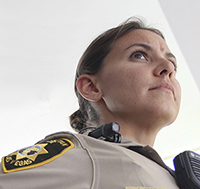
This is an archive of an Office of Justice Programs blog. This page is no longer updated and may contain outdated information and links that no longer function.
Research Shows Body-Worn Cameras Protect Law Enforcement
Wednesday, February 7, 2018
David B. Muhlhausen, Director, National Institute of Justice

Conversations about body-worn cameras have been a mainstay of public safety debates in recent years: whether they are effective, and to what degree they contribute to community safety and improve police interactions with citizens. Policymakers and criminal justice professionals have been eager to know how the use of this much-discussed technology can enhance the work of law enforcement, but we have had limited data to help us understand its true effectiveness and impact.
Now, new research sponsored by the National Institute of Justice determines that, in Las Vegas, body-worn cameras benefit the officers who wear them and the public they serve.
NIJ collaborated with the Las Vegas Metropolitan Police Department, the CNA Institute for Public Research, Northeastern University, and the University of Nevada, Las Vegas, on this major study, which consisted of a 12-month randomized control experiment involving 416 officers.
"When we first proposed the idea of body-worn cameras, our officers were reticent," said Sheriff Joe Lombardo of the LVMPD. "They were fearful that the cameras would be too intrusive on their job. What they quickly found out was that [the camera] became their best eyewitness.
"The camera serves as a tool to pull back the curtain on some of the situations our officers face and gives them an unvarnished view of incidents that are of great public interest. The outcome has allowed us to become more transparent and build trust with the public."
The study found that police are more proactive in preventing crime when they wear a camera. The cameras were found to provide compelling evidence to build legal cases, and their use largely affirmed and validated positive officer behavior. Members of the public submitted fewer complaints of officer misconduct, and the video record protected police from frivolous complaints. Officers who wore them were less likely, by more than 14 percent, to be called out in citizen complaints than those who did not.
Body-worn cameras also reduced use-of-force incidents. Combined with fewer complaints, this means that less time and money were spent on investigations ??? translating into significant cost savings. The study estimates net savings per camera-wearing officer to fall between $2,909 and $3,178 annually.
The findings reveal that body-worn cameras can help police on a number of levels: better evidence for cases that progress to courts; more relevant training based on analysis of captured footage; rapid resolution of complaints, due to the existence of video evidence; and law enforcement's increased transparency with the public. The work done in this study is helpful not only in Las Vegas, but to law enforcement, communities and policymakers across the country.
The public strongly supports the use of body-worn cameras by police officers. While the results of this study show the cameras' benefits, empirical research remains limited, and in some cases, contradictory. As with any criminal justice initiative, context matters. What worked in Las Vegas may not work in other cities. NIJ will continue to evaluate results on this topic, including those that reach different conclusions.

